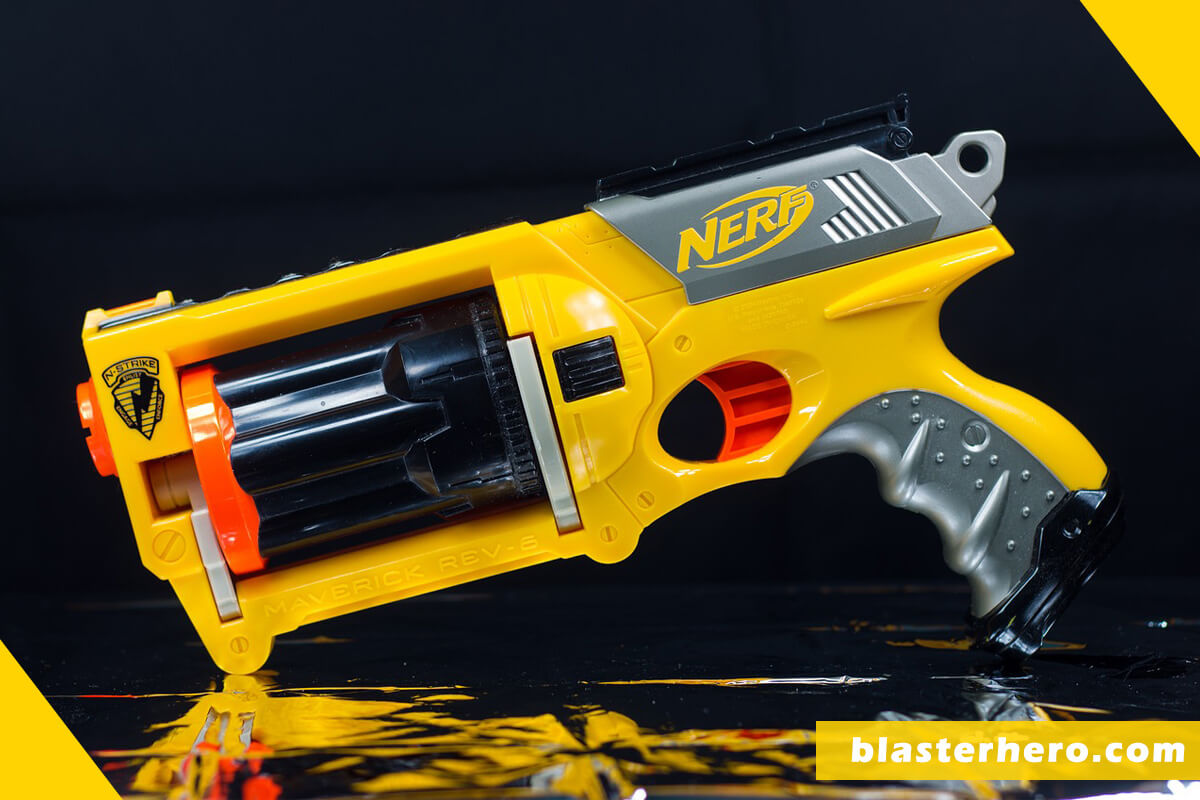Contents
- Who Invented the First Nerf Gun? A Brief History
Who Invented the First Nerf Gun? A Brief History
For generations of kids, Nerf guns have been a staple source of backyard fun. Those colorful foam dart blasters provide hours of entertainment through creative games and intense battles. But have you ever paused, amidst the flurry of foam, to ponder the history behind these iconic blasters? From their humble beginnings as squishy indoor balls to the sophisticated, customizable blasters we see today, the journey of Nerf guns is as intriguing as the games we play with them.
Dive with me into the labyrinth of Nerf history, where we’ll unearth its playful origins, its transformative years, and how a simple foam ball revolutionized the toy industry.
History of Nerf Gun: How it all began

Today I want to teach you about the super fun history of Nerf guns. Nerf guns are those colorful foam dart guns that many of you probably grew up playing with.
Back in 1969, a man named Reyn Guyer worked for a company called Parker Brothers. One day, Reyn was playing indoor volleyball and he had an idea. What if he made soft and safe balls for indoor games? That way, people could play games inside their homes without worrying about breaking anything!
Reyn made some prototype foam balls. His bosses at Parker Brothers liked the idea, so they bought Reyn’s idea and named it Nerf, after the nerf footballs that many people played with.
Short history and accomplishments of Reyn Guyer

Reyn Guyer is an American inventor, toy developer, and entrepreneur who has made significant contributions to the toy industry. Credited with over 200 toy inventions during his career spanning 4 decades. Dubbed “Father of Nerf” for creating one of the most iconic and beloved toy brands.
He was born in St. Paul, Minnesota, in 1935 and attended Dartmouth College. Guyer is best known for developing Twister in 1967 and the Nerf Ball in 1969, which he developed for Milton Bradley and Parker Brothers, respectively. He was inducted into the Hasbro Toy and Game Inventors’ Hall of Fame in 1986.
Guyer’s contributions to the toy industry have had a significant impact on the lives of children and adults alike, providing them with hours of entertainment and joy.
What Does the Name NERF Mean?
NERF was a made-up word that Guyer thought sounded fitting for a family-friendly toy brand. The whimsical name added to the playful appeal. NERF is actually an acronym that stands for Non-Expanding Recreational Foam. This refers to the unique properties of the soft, spongy foam material used to make the original NERF balls and toys.
The “Non-Expanding” part refers to how NERF foam does not expand or shrink over time. This allows NERF products to maintain a consistent size and shape.
“Recreational Foam” indicates NERF foam’s intended use for sports equipment, balls, and safe, indoor playthings. This distinguished it from industrial foams.
The squishy, lightweight nature of NERF foam meant it was less likely to break items or cause injury during energetic play. This made it perfect for games and toys. Guyer chose the name NERF to imply that his foam material was soft, harmless, and fun! It was inspired by the NERF football, a foam-filled football.
The first Nerf products: Nerf balls and bats

In 1970, Parker Brothers began selling the very first Nerf products – the Nerf balls and Nerf bats! The big, soft Nerf balls were perfect for playing catch or other games inside. The Nerf bats were also made of soft spongy foam so they couldn’t damage walls or break lamps if you hit them indoors.
In 1972, Parker Brothers made the first Nerf balls and indoor dart guns called the Nerf Blaster! The darts were made from soft, squishy foam so they couldn’t hurt anyone. Kids loved them!
The First Nerf Blasters: The evolution of Nerf toys in the 1980s
Ten years after releasing the world’s first indoor ball, Nerf decided to launch its first Nerf blaster called “Blast-a-Ball.” It was the first handheld foam weapon designed by Nerf that used a pump-action to shoot the ball. One year later, Nerf released its upgrade, the “Blast-a-Matic,” and this was the beginning of Nerf guns.
In 1991, Nerf released the Bow ‘n’ Arrow, its first gun to shoot arrows and the first of its kind to resemble a bow. The following year, the Sharpshooter was released, which was a turning point in the history of Nerf. Their famous slogan, “It’s Nerf or nothing,” was introduced in 1995.
The introduction of foam darts and blasters in the 1990s
- In 1991, Nerf released the Bow ‘n’ Arrow, its first gun to shoot arrows and the first of its kind to resemble a bow.
- 1992: The Sharpshooter – The Sharpshooter was the first blaster to shoot Nerf Darts, marking a significant milestone in the history of Nerf guns. It had a cartoonish design and was far from resembling a real weapon.
- 1994: Introduction of Nerf Action – The Original Nerf branding was discontinued, and a new branding called “Nerf Action” was introduced for the guns. This change aimed to define each series in the Nerf range and provide a fresh identity for the evolving line of blasters. Their famous slogan, “It’s Nerf or nothing,” was introduced in 1995.
- Late 1990s to Early 2000s: Acquisition by Hasbro – In this period, Hasbro fully acquired the Nerf brand, solidifying its position as a major player in the toy industry. Hasbro’s involvement brought increased resources and expertise to further develop and market Nerf products.
The Game-Changing Evolution of Nerf Guns: 2000 to Today
The development of Nerf guns from 2000 to today has seen significant changes and innovations. High Capacity Clips and Belts – many Nerf guns featured high capacity clip systems, drum magazines, and conveyor belts allowing 20-100 darts to be fired before reloading. This enabled sustained automatic dart barrages.
- Improved Power and Range: Nerf darts have gradually become faster, more accurate, and able to fly farther over the years. Key advancements include the Nerf Elite darts (2012) and Nerf Ultra darts (2018) which increased range to up to 120 feet.
- Improved Design: Nerf guns have undergone significant design improvements, with a focus on making them more realistic and functional. The Longshot, released in 2006, was the first blaster to come with reloadable magazines, which kids would fill with ammo and snap into place. The tactical rail on its barrel was designed to fit additional accessories, like sights, scopes, and shields, and foldout bipod legs added stability.
- Increased Range and Accuracy: Nerf has continued to improve the range and accuracy of its blasters. The Elite line, introduced in 2012, featured improved range and accuracy, making it easier to hit targets from a distance. The Ultra line, introduced in 2019, features advancements in accuracy and distance, with the Ultra One blaster capable of shooting darts up to 120 feet. The Ultra line, introduced in 2019, features advancements in accuracy and distance, with the Ultra One blaster capable of shooting darts up to 120 feet.
- Customization Options: Nerf has introduced new lines of blasters that allow for even more customization options. The Modulus line, introduced in 2015, allows users to customize their blasters with various attachments, including scopes, barrels, and stocks.
- Innovative Features: Nerf has continued to introduce new blasters with innovative features. The Rival line, introduced in 2015, features blasters that shoot high-impact rounds at high velocities, making them suitable for competitive play. The Vortex line, introduced in 2011, features blasters that shoot foam discs instead of darts, providing a unique gameplay experience.
- Pop Culture Collaborations: Nerf has collaborated with various pop culture franchises, including Star Wars, Marvel, and Fortnite, to create themed blasters. These collaborations have been immensely popular and have helped to expand the appeal of Nerf guns to a wider audience
Nerf Guns: A Journey from Simple to Sophisticated
The story of the Nerf gun illustrates how a simple toy idea can transform into an international phenomenon spanning generations. What began as an inventor’s concept for a safe indoor ball in the 1960s evolved into one of the most beloved toy franchises among children and adults alike.
Over the years, Nerf has continued to improve its blasters, with a focus on enhancing range, accuracy, and customization options. The brand has also collaborated with various pop culture franchises, including Star Wars, Marvel, and Fortnite, to create themed blasters. These collaborations have been immensely popular and have helped to expand the appeal of Nerf guns to a wider audience.
In conclusion, the Nerf pistol stands as a testament to innovation, adaptability, and the timeless appeal of fun. And while we’ve traversed its past, one can’t help but eagerly anticipate the next chapter in its journey. The future of the Nerf pistol promises more advancements, more excitement, and, undoubtedly, more foam-filled memories.

